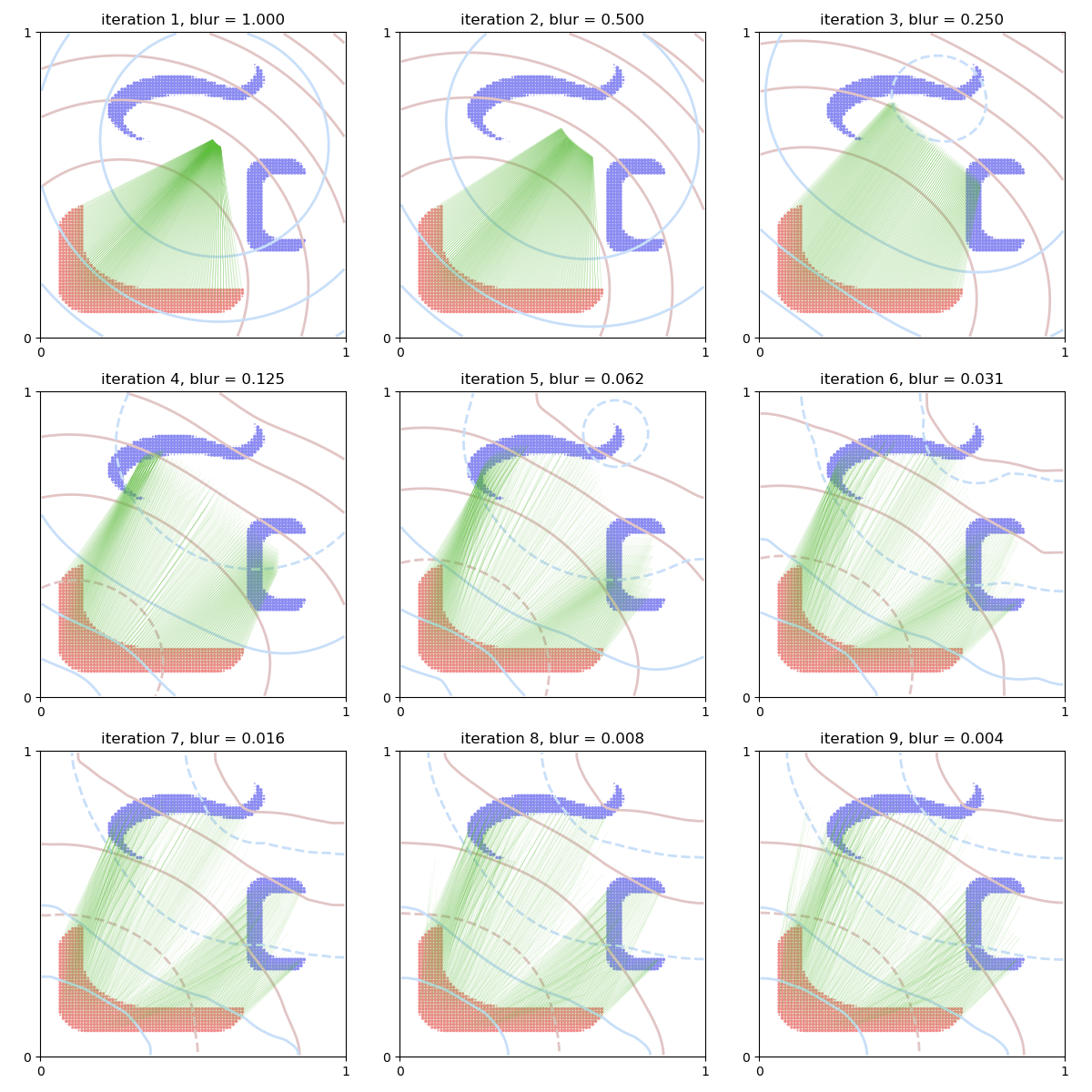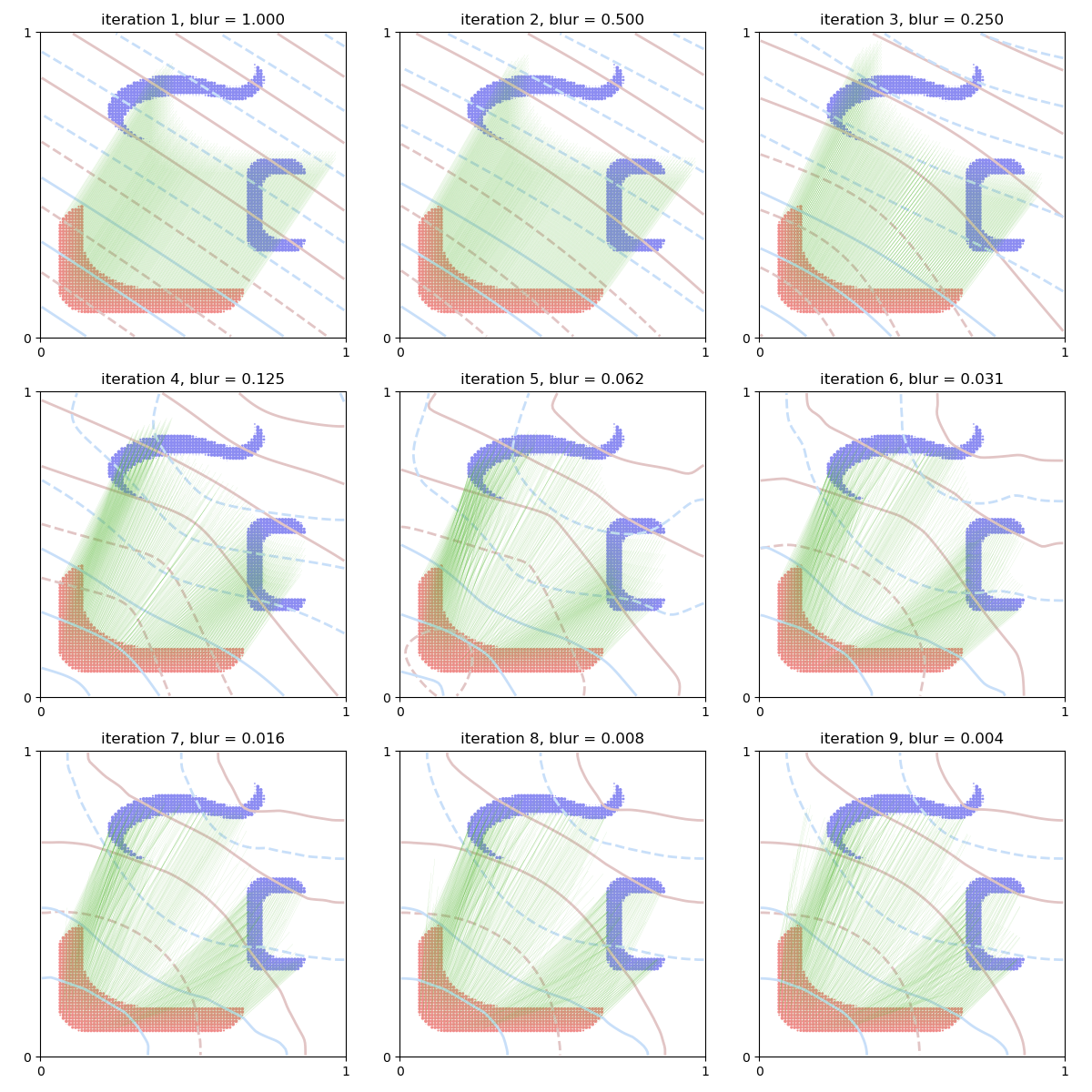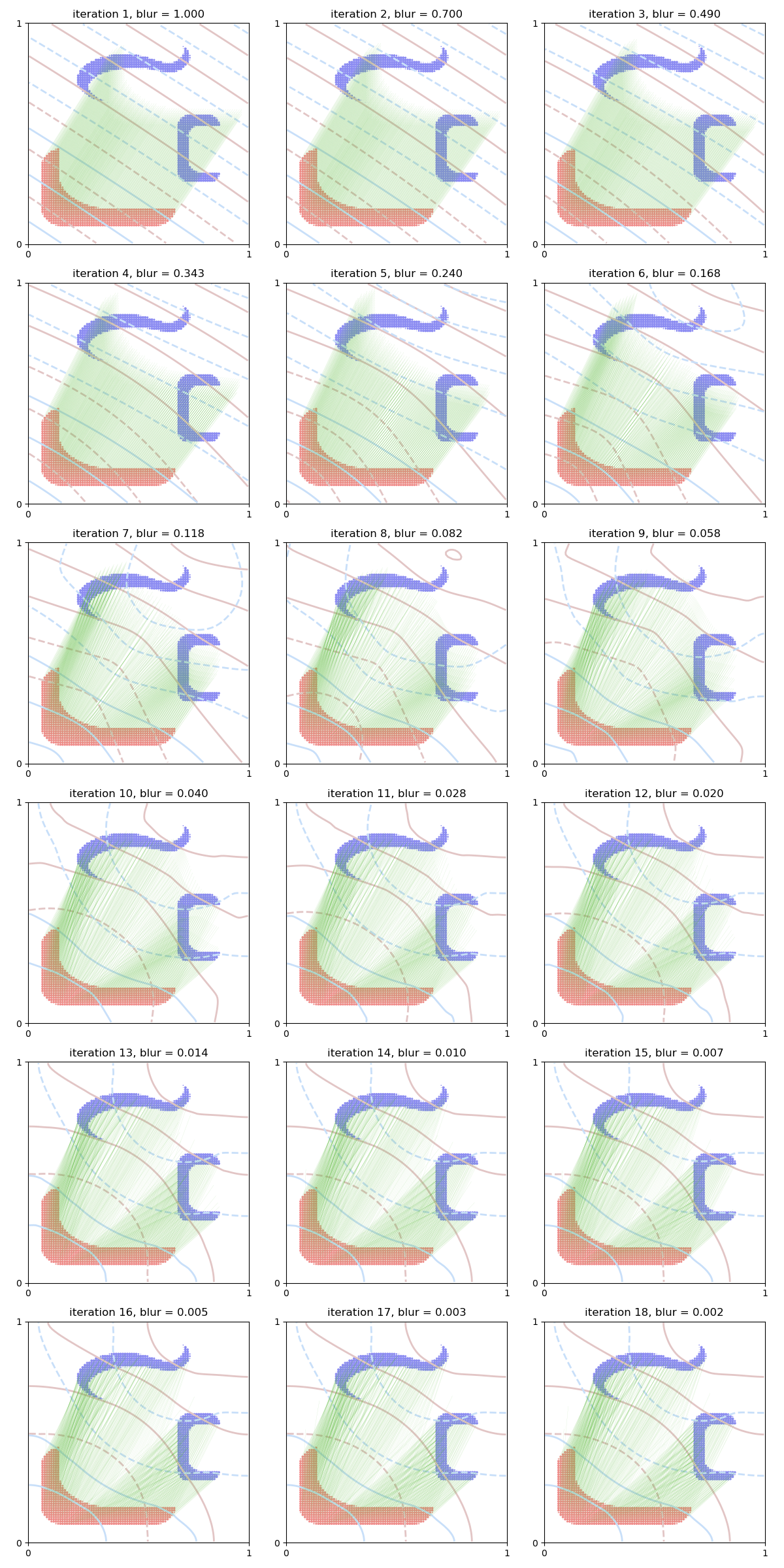Note
Go to the end to download the full example code
1) Blur parameter, scaling strategy
Dating back to the work of Schrödinger - see e.g. (Léonard, 2013) for a modern review - entropy-regularized Optimal Transport is all about solving the convex primal/dual problem:
where the linear Kantorovitch program is convexified by the addition of an entropic penalty - here, the generalized Kullback-Leibler divergence
The celebrated IPFP, SoftAssign and Sinkhorn algorithms are all equivalent to a block-coordinate ascent on the dual problem above and can be understood as smooth generalizations of the Auction algorithm, where a SoftMin operator
is used to update prices in the bidding rounds. This algorithm can be shown to converge as a Picard fixed-point iterator, with a worst-case complexity that scales in \(O( \max_{\alpha\otimes\beta} \text{C} \,/\,\varepsilon )\) iterations to reach a target numerical accuracy, as \(\varepsilon\) tends to zero.
Limitations of the (baseline) Sinkhorn algorithm. In most applications, the cost function is the squared Euclidean distance \(\text{C}(x,y)=\tfrac{1}{2}\|x-y\|^2\) studied by Brenier and subsequent authors, with a temperature \(\varepsilon\) that is homogeneous to the square of a blurring scale \(\sigma = \sqrt{\varepsilon}\).
With a complexity that scales in \(O( (\text{diameter}(\alpha, \beta) / \sigma)^2)\) iterations for typical configurations, the Sinkhorn algorithm thus seems to be restricted to high-temperature problems where the point-spread radius \(\sigma\) of the fuzzy transport plan \(\pi\) does not go below ~1/20th of the configuration’s diameter.
Scaling heuristic. Fortunately though, as often in operational research, simulated annealing can be used to break this computational bottleneck. First introduced for the \(\text{OT}_\varepsilon\) problem in (Kosowsky and Yuille, 1994), this heuristic is all about decreasing the temperature \(\varepsilon\) across the Sinkhorn iterations, letting prices adjust in a coarse-to-fine fashion.
The default behavior of the SamplesLoss("sinkhorn") layer
is to let \(\varepsilon\) decay according to an exponential schedule.
Starting from a large value of \(\sigma = \sqrt{\varepsilon}\),
estimated from the data or given through the diameter parameter,
we multiply this blurring scale by a fixed scaling
coefficient in the \((0,1)\) range and loop until \(\sigma\)
reaches the target blur value.
We thus work with decreasing values of the temperature \(\varepsilon\) in
with an effective number of iterations that is equal to:
Let us now illustrate the behavior of the Sinkhorn loop across these iterations, on a simple 2d problem.
Setup
Standard imports:
import numpy as np
import matplotlib.pyplot as plt
import time
import torch
from torch.autograd import grad
use_cuda = torch.cuda.is_available()
dtype = torch.cuda.FloatTensor if use_cuda else torch.FloatTensor
Display routines:
from imageio import imread
def load_image(fname):
img = np.mean(imread(fname), axis=2) # Grayscale
img = (img[::-1, :]) / 255.0
return 1 - img
def draw_samples(fname, sampling, dtype=torch.FloatTensor):
A = load_image(fname)
A = A[::sampling, ::sampling]
A[A <= 0] = 1e-8
a_i = A.ravel() / A.sum()
x, y = np.meshgrid(
np.linspace(0, 1, A.shape[0]),
np.linspace(0, 1, A.shape[1]),
indexing="xy",
)
x += 0.5 / A.shape[0]
y += 0.5 / A.shape[1]
x_i = np.vstack((x.ravel(), y.ravel())).T
return torch.from_numpy(a_i).type(dtype), torch.from_numpy(x_i).contiguous().type(
dtype
)
def display_potential(ax, F, color, nlines=21):
# Assume that the image is square...
N = int(np.sqrt(len(F)))
F = F.view(N, N).detach().cpu().numpy()
F = np.nan_to_num(F)
# And display it with contour lines:
levels = np.linspace(-1, 1, nlines)
ax.contour(
F,
origin="lower",
linewidths=2.0,
colors=color,
levels=levels,
extent=[0, 1, 0, 1],
)
def display_samples(ax, x, weights, color, v=None):
x_ = x.detach().cpu().numpy()
weights_ = weights.detach().cpu().numpy()
weights_[weights_ < 1e-5] = 0
ax.scatter(x_[:, 0], x_[:, 1], 10 * 500 * weights_, color, edgecolors="none")
if v is not None:
v_ = v.detach().cpu().numpy()
ax.quiver(
x_[:, 0],
x_[:, 1],
v_[:, 0],
v_[:, 1],
scale=1,
scale_units="xy",
color="#5CBF3A",
zorder=3,
width=2.0 / len(x_),
)
Dataset
Our source and target samples are drawn from measures whose densities are stored in simple PNG files. They allow us to define a pair of discrete probability measures:
sampling = 10 if not use_cuda else 2
A_i, X_i = draw_samples("data/ell_a.png", sampling)
B_j, Y_j = draw_samples("data/ell_b.png", sampling)
/home/code/geomloss/geomloss/examples/sinkhorn_multiscale/plot_epsilon_scaling.py:115: DeprecationWarning: Starting with ImageIO v3 the behavior of this function will switch to that of iio.v3.imread. To keep the current behavior (and make this warning disappear) use `import imageio.v2 as imageio` or call `imageio.v2.imread` directly.
img = np.mean(imread(fname), axis=2) # Grayscale
Scaling strategy
We now display the behavior of the Sinkhorn loss across our iterations.
from geomloss import SamplesLoss
def display_scaling(scaling=0.5, Nits=9, debias=True):
plt.figure(figsize=((12, ((Nits - 1) // 3 + 1) * 4)))
for i in range(Nits):
blur = scaling**i
Loss = SamplesLoss(
"sinkhorn", p=2, blur=blur, diameter=1.0, scaling=scaling, debias=debias
)
# Create a copy of the data...
a_i, x_i = A_i.clone(), X_i.clone()
b_j, y_j = B_j.clone(), Y_j.clone()
# And require grad:
a_i.requires_grad = True
x_i.requires_grad = True
b_j.requires_grad = True
# Compute the loss + gradients:
Loss_xy = Loss(a_i, x_i, b_j, y_j)
[F_i, G_j, dx_i] = grad(Loss_xy, [a_i, b_j, x_i])
# The generalized "Brenier map" is (minus) the gradient of the Sinkhorn loss
# with respect to the Wasserstein metric:
BrenierMap = -dx_i / (a_i.view(-1, 1) + 1e-7)
# Fancy display: -----------------------------------------------------------
ax = plt.subplot(((Nits - 1) // 3 + 1), 3, i + 1)
ax.scatter([10], [10]) # shameless hack to prevent a slight change of axis...
display_potential(ax, G_j, "#E2C5C5")
display_potential(ax, F_i, "#C8DFF9")
display_samples(ax, y_j, b_j, [(0.55, 0.55, 0.95)])
display_samples(ax, x_i, a_i, [(0.95, 0.55, 0.55)], v=BrenierMap)
ax.set_title("iteration {}, blur = {:.3f}".format(i + 1, blur))
ax.set_xticks([0, 1])
ax.set_yticks([0, 1])
ax.axis([0, 1, 0, 1])
ax.set_aspect("equal", adjustable="box")
plt.tight_layout()
The entropic bias. In the first round of figures, we focus on the classic, biased loss
where \(f\) and \(g\) are solutions of the dual problem above. Displayed in the background, the dual potentials
evolve from simple convolutions of the form \(\text{C}\star\alpha\), \(\text{C}\star\beta\) (when \(\varepsilon\) is large) to genuine Kantorovitch potentials (when \(\varepsilon\) tends to zero).
Unfortunately though, as was first illustrated in (Chui and Rangarajan, 2000), the \(\text{OT}_\varepsilon\) loss suffers from an entropic bias: its Lagrangian gradient \(-\tfrac{1}{\alpha_i}\partial_{x_i} \text{OT}(\alpha,\beta)\) (i.e. its gradient for the Wasserstein metric) points towards the inside of the target measure \(\beta\), as points get attracted to the Fréchet mean of their \(\varepsilon\)-targets specified by the fuzzy transport plan \(\pi\).
display_scaling(scaling=0.5, Nits=9, debias=False)

Unbiased Sinkhorn divergences. To alleviate this mode collapse phenomenon, an idea that recently emerged in the Machine Learning community is to use the unbiased Sinkhorn loss (Ramdas et al., 2015):
which interpolates between a Wasserstein distance (when \(\varepsilon \rightarrow 0\)) and a kernel norm (when \(\varepsilon \rightarrow +\infty\)). In (Feydy et al., 2018), this formula was shown to define a positive, definite, convex loss function that metrizes the convergence in law. Crucially, as detailed in (Feydy and Trouvé, 2018), it can also be written as
where \((f,g) = (b^{\beta\rightarrow\alpha},a^{\alpha\rightarrow\beta})\) is a solution of \(\text{OT}_\varepsilon(\alpha,\beta)\) and \(a^{\alpha\leftrightarrow\alpha}\), \(b^{\beta\leftrightarrow\beta}\) are the unique solutions of \(\text{OT}_\varepsilon(\alpha,\alpha)\) and \(\text{OT}_\varepsilon(\beta,\beta)\) on the diagonal of the space of potential pairs.
As evidenced by the figures below, the unbiased dual potentials
interpolate between simple linear forms (when \(\varepsilon\) is large) and genuine Kantorovitch potentials (when \(\varepsilon\) tends to zero).
A generalized Brenier map. Instead of suffering from shrinking artifacts, the Lagrangian gradient of the Sinkhorn divergence interpolates between an optimal translation and an optimal transport plan. Understood as a smooth generalization of the Brenier mapping, the displacement field
can thus be used as a blurred transport map that registers measures up to a detail scale specified through the blur parameter.
# sphinx_gallery_thumbnail_number = 2
display_scaling(scaling=0.5, Nits=9)

As a final note: please remember that the trade-off between speed and accuracy can be simply set by changing the value of the scaling parameter. By choosing a decay of \(.7 \simeq \sqrt{.5}\) between successive values of the blurring radius \(\sigma = \sqrt{\varepsilon}\), we effectively double the number of iterations spent to solve our dual optimization problem and thus improve the quality of our matching:
display_scaling(scaling=0.7, Nits=18)
plt.show()

Total running time of the script: (0 minutes 8.340 seconds)